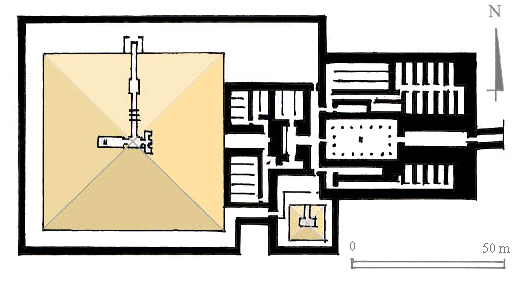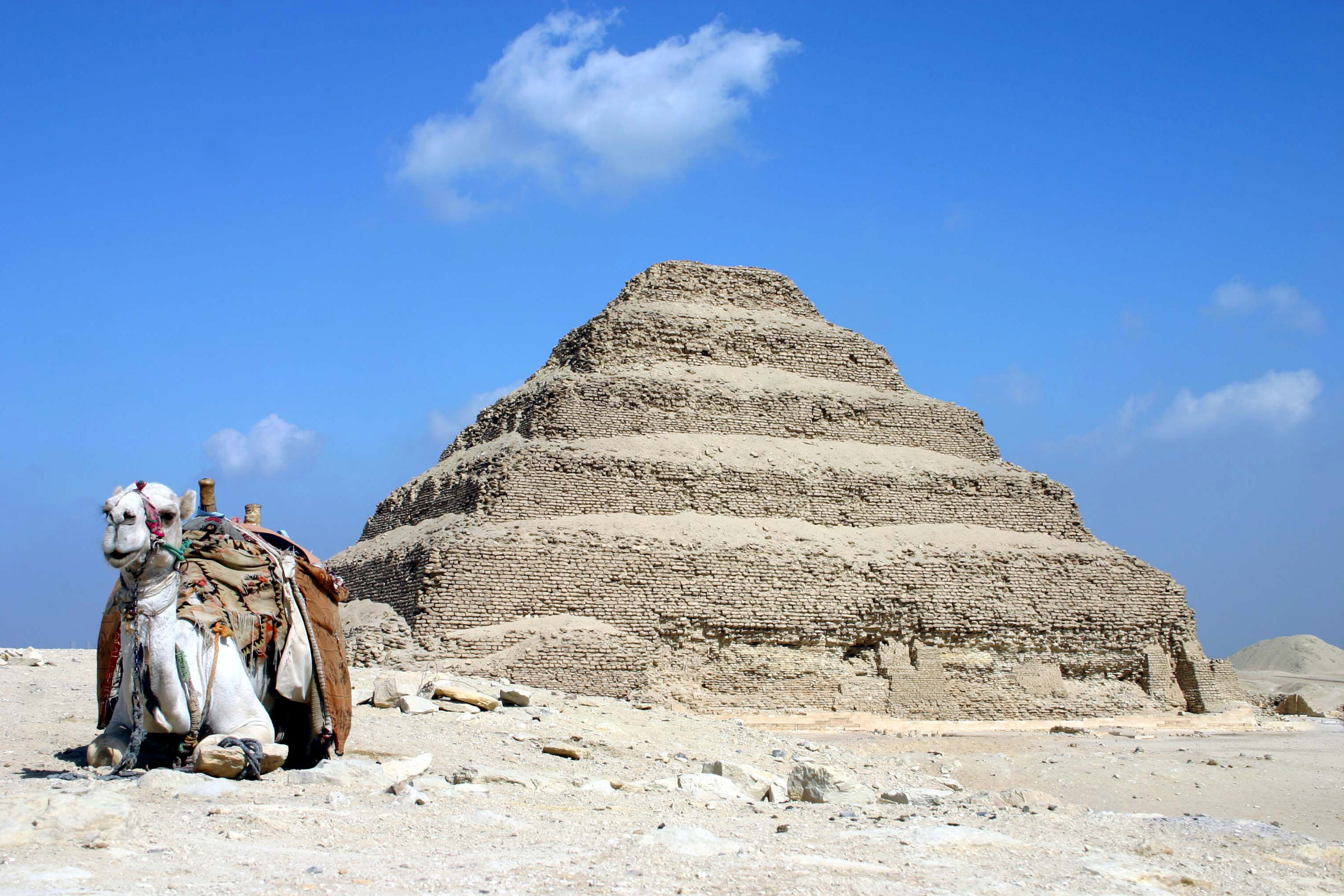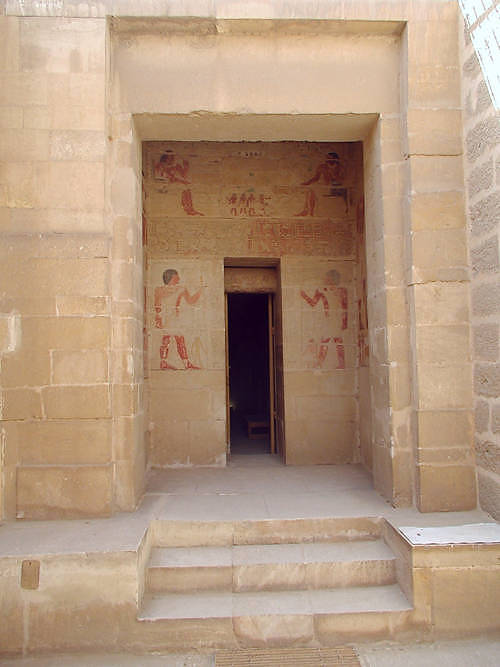|
Saqqara
Saqqara ( ar, سقارة, ), also spelled Sakkara or Saccara in English , is an Egyptian village in Giza Governorate, that contains ancient burial grounds of Egyptian royalty, serving as the necropolis for the ancient Egyptian capital, Memphis. Saqqara contains numerous pyramids, including the Step pyramid of Djoser, sometimes referred to as the Step Tomb, and a number of mastaba tombs. Located some south of modern-day Cairo, Saqqara covers an area of around . Saqqara contains the oldest complete stone building complex known in history, the Pyramid of Djoser, built during the Third Dynasty. Another sixteen Egyptian kings built pyramids at Saqqara, which are now in various states of preservation. High officials added private funeral monuments to this necropolis during the entire Pharaonic period. It remained an important complex for non-royal burials and cult ceremonies for more than 3,000 years, well into Ptolemaic and Roman times. North of the area known as Saqqara lie ... [...More Info...] [...Related Items...] OR: [Wikipedia] [Google] [Baidu] |
Serapeum Of Saqqara
The Serapeum of Saqqara was the ancient Egyptian burial place for sacred bulls of the Apis (deity), Apis cult at Memphis, Egypt, Memphis. It was believed that the bulls were incarnations of the god Ptah, which would become immortal after death as ''Osiris-Apis''. a name which evolved to ''Userhapi'' () in Coptic language, Coptic, and ''Serapis (''), in the Hellenistic period. Over a timespan of approximately 1400 years, from the New Kingdom of Egypt to the Ptolemaic Period, at least sixty Apis are attested to have been interred at the Serapeum. The earliest burials are found in isolated tombs, as the cult gained importance underground galleries were dug that connected subsequent burial chambers. One of the cult practices involved the dedication of commemorative Stele, stone tablets with dates relating to the life and death of the Apis. This data was crucial for the establishment of an Egyptian chronology in the 19th century. It is part of the Saqqara, Saqqara necropolis, which in ... [...More Info...] [...Related Items...] OR: [Wikipedia] [Google] [Baidu] |
Memphis, Egypt
, alternate_name = , image = , alt = , caption = Ruins of the pillared hall of Ramesses IIat Mit Rahina , map_type = Egypt#Africa , map_alt = , map_size = , relief = , coordinates = , location = Mit Rahina, Giza Governorate, Egypt , region = Lower Egypt , type = Settlement , part_of = , length = , width = , area = , height = , builder = Unknown, was already in existence during Iry-Hor's reignP. Tallet, D. Laisnay: ''Iry-Hor et Narmer au Sud-Sinaï (Ouadi 'Ameyra), un complément à la chronologie des expéditios minière égyptiene'', in: BIFAO 112 (2012), 381–395available online/ref> , material = , built = Earlier than 31st century BC , abandoned = 7th century AD , epochs = Early Dynastic Period to Early Middle Ages , cultures = , dependency_of = , occupants = , event ... [...More Info...] [...Related Items...] OR: [Wikipedia] [Google] [Baidu] |
Mortuary Complex Of Pepi I
The pyramid of Pepi I (in ancient Egyptian Men-nefer-Pepi meaning Pepi's splendour is enduring) is the pyramid complex built for the Egyptian pharaoh Pepi I of the Sixth Dynasty in the 24th or 23rd century BC. The complex gave its name to the capital city of Egypt, Memphis. As in the pyramids of his predecessors, Pepi I's substructure was filled with vertical columns of hieroglyphic texts, Pyramid Texts. It was in Pepi I's pyramid that these texts were initially discovered in 1880 by Gaston Maspero, though they originated in the pyramid of Unas. The corpus of Pepi I's texts is also the largest from the Old Kingdom, comprising 2,263 columns and lines of hieroglyphs. Pepi I sited his pyramid complex in South Saqqara an approximate north of Djedkare Isesi's pyramid. It is unclear why Pepi I relocated to South Saqqara. Perhaps Pepi I had moved the royal palace south and away from the city, or perhaps no viable sites were left in North and Central Saqqara after Teti built his pyr ... [...More Info...] [...Related Items...] OR: [Wikipedia] [Google] [Baidu] |
Pyramid Fields From Giza To Dahshur
The Egyptian pyramids are ancient masonry structures located in Egypt. Sources cite at least 118 identified "Egyptian" pyramids. Approximately 80 pyramids were built within the Kingdom of Kush, now located in the modern country of Sudan. Of those located in modern Egypt, most were built as tombs for the country's pharaohs and their consorts during the Old Kingdom of Egypt, Old and Middle Kingdom of Egypt, Middle Kingdom periods. The earliest known Egyptian pyramids are found at Saqqara, northwest of Memphis, Egypt, Memphis, although at least one step-pyramid-like structure has been found at Saqqara, dating to the First Dynasty of Egypt, First Dynasty: Mastaba 3808, which has been attributed to the reign of Pharaoh Anedjib, with inscriptions, and other archaeological remains of the period, suggesting there may have been others. The otherwise earliest among these is the Pyramid of Djoser built during the Third dynasty of Egypt, Third Dynasty. This pyramid and its surroun ... [...More Info...] [...Related Items...] OR: [Wikipedia] [Google] [Baidu] |
Pyramid Of Unas
The pyramid of Unas (Egyptian: ''Nfr swt Wnjs'' "Beautiful are the places of Unas") is a smooth-sided pyramid built in the 24th century BC for the Egyptian pharaoh Unas, the ninth and final king of the Fifth Dynasty. It is the smallest Old Kingdom pyramid, but significant due to the discovery of Pyramid Texts, spells for the king's afterlife incised into the walls of its subterranean chambers. Inscribed for the first time in Unas's pyramid, the tradition of funerary texts carried on in the pyramids of subsequent rulers, through to the end of the Old Kingdom, and into the Middle Kingdom through the Coffin Texts that form the basis of the ''Book of the Dead''. Unas built his pyramid between the complexes of Sekhemket and Djoser, in North Saqqara. Anchored to the valley temple at a nearby lake, a long causeway was constructed to provide access to the pyramid site. The causeway had elaborately decorated walls covered with a roof which had a slit in one section allowing light to e ... [...More Info...] [...Related Items...] OR: [Wikipedia] [Google] [Baidu] |
Pyramid Of Djedkare Isesi
The pyramid of Djedkare Isesi (in ancient Egyptian ''Nfr Ḏd-kꜣ-rꜥ'' ("Beautiful is Djedkare")) is a late 25th to mid 24th century BC pyramid complex built for the Fifth Dynasty pharaoh Djedkare Isesi. The pyramid is referred to as ''Haram el-Shawaf'' ( ar, هَرَم ٱلشَّوَّاف, Haram ash-Shawwāf, lit=The Sentinel Pyramid) by locals. It was the first pyramid to be built in South Saqqara. Djedkare Isesi's monument complex encompasses: a main pyramid; a mortuary temple situated on the east face of the main pyramid; a valley temple buried under modern Saqqara; a causeway that has been only partially dug out; and a cult pyramid. The main pyramid had a six-stepped core built from roughly cut limestone bound together by clay mortar which was then encased in fine white Tura limestone reaching a peak height of . The casing has been plundered, and the top three steps of the core have been lost, leaving the pyramid a paltry tall. The basic dimensions of Djedkare's pyr ... [...More Info...] [...Related Items...] OR: [Wikipedia] [Google] [Baidu] |
Pyramid Of Djoser
The pyramid of Djoser (or Djeser and Zoser), sometimes called the Step Pyramid of Djoser, is an archaeological site in the Saqqara necropolis, Egypt, northwest of the ruins of Memphis. The 6-tier, 4-sided structure is the earliest colossal stone building in Egypt. It was built in the 27th century BC during the Third Dynasty for the burial of Pharaoh Djoser. The pyramid is the central feature of a vast mortuary complex in an enormous courtyard surrounded by ceremonial structures and decoration. Its architect was Imhotep, chancellor of the pharaoh and high priest of the god Ra. The pyramid went through several revisions and redevelopments of the original plan. The pyramid originally stood tall, with a base of and was clad in polished white limestone. The step pyramid (or proto-pyramid) was considered to be the earliest large-scale cut stone construction made by man as of 1997, although the nearby enclosure wall "Gisr el-Mudir" is suggested by some Egyptologists to predate the com ... [...More Info...] [...Related Items...] OR: [Wikipedia] [Google] [Baidu] |
Pyramid Of Userkaf
The pyramid complex of Userkaf was built c. 2490 BC for the pharaoh Userkaf (reigned 2494–2487 BC), founder of the 5th Dynasty of Egypt (c. 2494–2345 BC). It is located in the pyramid field at Saqqara, on the north-east of the step pyramid of Djoser (reigned c. 2670 BC). Constructed in dressed stone with a core of rubble, the pyramid is now ruined and resembles a conical hill in the sands of Saqqara.Mark Lehner, ''The Complete Pyramids'', Thames & Hudson, , p. 140 For this reason, it is known locally as ''El-Haram el-Maharbish'', the "Heap of Stone",Jean-Phillipe Lauer (in French): ''Saqqarah, Une vie, Entretiens avec Phillipe Flandrin'', Petite Bibliotheque Payot 107, 1988, and was recognized as a royal pyramid by western archaeologists in the 19th century. Userkaf's pyramid is part of a larger mortuary complex comprising a mortuary temple, an offering chapel and a cult pyramid as well as separate pyramid and mortuary temple for Userkaf's wife, queen Neferhet ... [...More Info...] [...Related Items...] OR: [Wikipedia] [Google] [Baidu] |
Pyramid Of Teti
The pyramid of Teti is a smooth-sided pyramid situated in the pyramid field at Saqqara in Egypt. It is the second known pyramid containing pyramid texts. Excavations have revealed a satellite pyramid, two pyramids of queens accompanied by cult structures, and a funerary temple. The pyramid was opened by Gaston Maspero in 1882 and the complex explored during several campaigns ranging from 1907 to 1965. It was originally called ''Teti's Places Are Enduring''. The preservation above ground is very poor, and it now resembles a small hill. Below ground the chambers and corridors are very well preserved. The funerary complex The pyramid complex of Teti follows a model established during the reign of Djedkare Isesi, the arrangement of which is inherited from the funerary complexes of Abusir. A valley temple, now lost, was probably destroyed in antiquity due to the place of an Old Kingdom temple dedicated to Anubis constructed there. A better known funerary temple, revealed by Jame ... [...More Info...] [...Related Items...] OR: [Wikipedia] [Google] [Baidu] |
Gisr El-Mudir
Gisr el-Mudir (Arabic:جسر المدير, "bridge of the chief") also known as the Great Enclosure, is one of the oldest known stone structures in Egypt, located at Saqqara only a few hundred metres west of the Step Pyramid and the Buried Pyramid. The function of the space is not yet clear. Description The structure consists of a rectangular wall oriented north-south and measuring about 650 by 350 metres. The walls consist of two outer walls made of roughly hewn limestone about 15 metres apart; the space between them is filled with crushed stone, gravel and sand. In the northwestern corner, the walls survive to a height of 4.5 to 5 metres (over 15 courses of stone). The style of construction suggests an original height of around 10 metres. In the south the state of preservation is clearly worse than in the north. Since the west wall of the structure is 30 metres shorter than the east, the south wall probably consisted of two parallel walls forming an entranceway. This pattern ... [...More Info...] [...Related Items...] OR: [Wikipedia] [Google] [Baidu] |
Third Dynasty Of Egypt
The Third Dynasty of ancient Egypt (Dynasty III) is the first dynasty of the Old Kingdom. Other dynasties of the Old Kingdom include the Fourth, Fifth and Sixth. The capital during the period of the Old Kingdom was at Memphis. Overview After the turbulent last years of the Second Dynasty, which might have included civil war, Egypt came under the rule of Djoser, marking the beginning of the Third Dynasty.Dodson, Hilton, ''The Complete Royal Families of Ancient Egypt'', 2004 Both the Turin King List and the Abydos King List record five kings,Toby A.H. Wilkinson, ''Early Dynastic Egypt'', Routledge, 2001 while the Saqqara Tablet only records four, and Manetho records nine,Aidan Dodson: ''The Layer Pyramid of Zawiyet el-Aryan: Its Layout and Context.'' In: ''Journal of the American Research Center in Egypt (JARCE)'', No. 37 (2000). American Research Center (Hg.), Eisenbrauns, Winona Lake/Bristol 2000, , pp. 81–90. many of whom did not exist or are simply the same king unde ... [...More Info...] [...Related Items...] OR: [Wikipedia] [Google] [Baidu] |
Khnumhotep And Niankhkhnum
Khnumhotep ( egy, ẖnm.w-ḥtp(.w)) and Niankhkhnum ( egy, nj-ꜥnḫ-ẖnm.w) were ancient Egyptian royal servants. They shared the title of Overseer of the Manicurists in the Palace of King Nyuserre Ini, sixth pharaoh of the Fifth Dynasty, reigning during the second half of the 25th century BC. They were buried together at Saqqara and are listed as "royal confidants" in their joint tomb. They are notable for their unusual depiction in Egyptian records, often interpreted as the first recorded same-sex couple,. Family Khnumhotep and Niankhkhnum are believed by scholars, including Thomas Dowson, and Greg Reeder, to be the first recorded same-sex couple in ancient history. The assumed romantic relationship between Khnumhotep and Niankhkhnum is based on depictions of the two men standing nose to nose and embracing. Niankhkhnum's wife, depicted in a banquet scene, was almost completely erased in antiquity, and in other pictures Khnumhotep occupies the position usually designated f ... [...More Info...] [...Related Items...] OR: [Wikipedia] [Google] [Baidu] |







.png)

